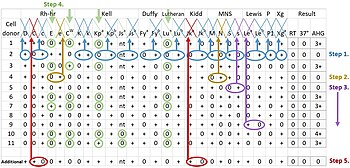Lutheran antigen system

The Lutheran antigen systems is a classification of human blood based on the presence of substances called Lutheran antigens on the surfaces of red blood cells. There are 19 known Lutheran antigens.[1] The name Lutheran stems from a blood donor's misspelled last name, reportedly named Lutteran or Luteran.[2][3][4][5] All of these antigens arise from variations in a gene called BCAM (basal cell adhesion molecule). The system is based on the expression of two codominant alleles, designated Lua and Lub. The antigens Aua and Aub, known as the Auberger antigens, were once thought to make up a separate blood group but were later shown to be Lutheran antigens arising from variations in the BCAM gene.
The
erythroblastosis fetalis
or of transfusion reactions.

Notes
- ISBN 978-0-7817-6507-7.
- S2CID 41855884.
- PMID 23421542.
- ^ Meunier, D; Peng, S; Clarke, G. "Lutheran system: Anti-Lua". Serological best practices. Ottawa: Canadian Blood Services. Retrieved 9 November 2023.
- ^ "Blood Group System - Lutheran". SCARF, Serum, cells, and rare fluids exchange. Retrieved 9 November 2023.
